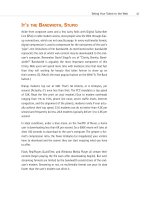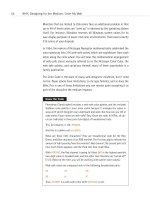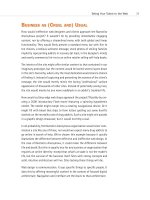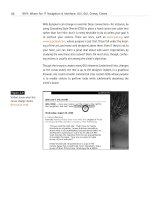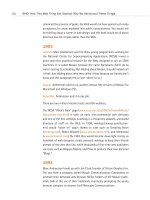Taking Your Talent to the Web- P11 pps
Bạn đang xem bản rút gọn của tài liệu. Xem và tải ngay bản đầy đủ của tài liệu tại đây (195.5 KB, 15 trang )
Do not actually look at the Gantt Charts, however. They will only frighten
you and make you feel hopeless and uncreative. Don’t worry about missing
any deadlines. The project managers will be “casually dropping by” your
cubicle every 15 minutes for the next 40 years, and you won’t miss a sin-
gle deadline. See, what did we tell you? They’re exactly like account
executives.
Systems administrator (sysadmin) and network
administrator (netadmin)
Sysadmins and netadmins are also called network engineers, database
administrators, directors of web development, webgods, UNIX guys, NT
guys, Linux guys, and geeks (formerly often called “webmasters”)—these
are the people who run the server (computer) that houses the site you’re
developing. They also run the staging server where you might build the site
before actually “publishing” it to the Web.
In some companies these folks are woefully underpaid juniors with exten-
sive computing knowledge. In others, they’re woefully overpaid juniors
without any computing experience at all, which is why many old-school
webmasters now call themselves systems administrators, network engi-
neers, database administrators, and so forth, leaving the webmaster
moniker to the temp who answers email about the site.
Most sysadmins are senior employees in charge of a staff. In small compa-
nies, they also might be the folks you go to when you need software
installed on your computer or if you’re having trouble with your email. In
larger companies, an IT person typically handles those responsibilities. In
some companies, sysadmins are also developers and in others, they are not.
Some companies call their sysadmins developers. Some call their juniors
seniors—because titles are easier to come up with than salary. Some say
love is like a flower. Don’t let any of this drive you mad. Above all, respect
the sysadmins. Without them, we’d have no Web.
Web technician
Web technicians, also called producers, web producers, HTML jockeys, web-
monkeys, web practitioners, HTML practitioners, design technicians, HTML
technicians, geeks, and many other things, are folks who do a job similar
to that of the studio people in an ad agency. As studio people take an art
131
Taking Your Talent to the Web
08 0732 CH05 4/24/01 11:18 AM Page 131
director’s comp and make technologically-oriented changes to it so that it
can be handed off to a printer, web technicians take a web designer’s Pho-
toshop comp, cut it apart, and render it in HTML, JavaScript, and other lan-
guages as needed. They also will render the graphic elements in
web-appropriate formats.
If you were wondering, the difference between web technicians and web
developers is largely a matter of experience, knowledge, and salary. A web
technician may cut your comp apart and write HTML; a web developer is
more like a technology designer who envisions powerful transactions and
writes advanced code in several different languages to bring those visions
to life.
Web developers are as critical to the process as lead designers, whereas
web technicians are more like junior designers. Junior designers might cre-
ate buttons or develop alternate color schemes under the supervision of a
senior designer; similarly, web technicians generally do lower-level pro-
gramming tasks than web developers. Some don’t program at all but sim-
ply use cut-and-paste JavaScripts (as do many web designers).
In smaller companies (or in large companies when there is a time crunch),
there are no web technicians; web designers execute their own designs in
HTML, JavaScript, and other languages as needed. This book will prepare
you to do that part of the job, making you that much more employable and
giving you that much more control over the process. (And as designers, we
all like control.)
Even if you always work in large companies, your knowledge of these
processes will enable you to work closely with web technicians, often in a
supervisory capacity—as if they were junior designers helping you execute
your campaign. It also will enable you to self-publish your creative work if
you find, as many of us do, that the Web is the greatest thing since sliced
bread, and you have an urge to do creative work even after hours.
We started this chapter by mentioning that titles are often confusing in
this business. The same thing holds for job responsibilities. While there are
plenty of junior and mid-level web technicians, there are also web devel-
opers who handle these tasks. Regardless of anyone’s stature, it goes with-
out saying that you should be respectful to all your teammates because
that makes life better.
132
WHO: The Obligatory Glossary: Roles and Responsibilities in the Web World
08 0732 CH05 4/24/01 11:18 AM Page 132
And speaking of you…
YOUR ROLE IN THE WEB
Will be covered in the very next chapter. Go there.
133
Taking Your Talent to the Web
08 0732 CH05 4/24/01 11:18 AM Page 133
08 0732 CH05 4/24/01 11:18 AM Page 134
chapter 6
What Is a Web Designer,
Anyway?
WE’VE EXPLORED THE STRENGTHS AND LIMITATIONS of the Web as a unique
medium; considered architecture and navigation as key components of the
user experience; glanced at the medium’s history; defined technical terms;
and examined the roles played by your coworkers. Maybe it’s time to look
at your job on the Web. We’ll start with a working definition.
Definition
Web designers are professionals who solve a client’s communication problems
and leverage the client’s brand identity in a web-specific way.
Complementing this focus on the client’s needs, web designers must think like
the site’s anticipated audience. They foresee what visitors will want to do
on the site and create navigational interfaces that facilitate those needs.
Pretty dry stuff, we’ll grant you, but like marital bliss, it’s better than it
sounds.
How does all this fancy talk break down in terms of daily tasks? Below is a
summary of deeds you’ll do during the web development project life cycle.
In Chapter 7, “Riding the Project Life Cycle,” we delve into details.
09 0732 CH06 4/24/01 11:18 AM Page 135
Through the project life cycle, the web designer will need to:
■ Understand and discuss the underlying technology—its possibilities
and limitations as well as related issues—with clients and team
members.
■ Translate client needs, content, and branding into structured web-
site concepts.
■ Translate projected visitor needs into structured website
concepts.
■ Translate website concepts into appropriate, technically
executable color comps.
■ Design navigation elements.
■ Establish the look and feel of web pages, including typography,
graphics, color, layout, and other factors.
■ Render design elements from Photoshop, Illustrator, and other visual
development environments into usable elements of a working
website.
■ Lay out web pages and sites using HTML and other web development
languages.
■ Organize and present content in a readable, well-designed way.
■ Effectively participate on a web development team.
■ Modify graphics and code as needed (for instance, when technolog-
ical incompatibilities arise or when clients’ business models change—
as they often do in this business).
■ Program HTML, JavaScript, and style sheets as needed. In larger
agencies, this work is often performed by web developers and tech-
nicians (see Chapter 5, “The Obligatory Glossary”), but the accom-
plished web designer must be ready to do any or all of these tasks as
needed.
■ Try not to curse browser makers, clients, or team members, as obsta-
cles are encountered throughout the process. (Well, go ahead and
curse browser makers if you want to.)
136
WHO: What Is a Web Designer, Anyway?
09 0732 CH06 4/24/01 11:18 AM Page 136
■ Update and maintain client sites as needed. Though this job, too,
often falls to web technicians or producers, don’t think you’re off the
hook. You’re never off the hook.
WHAT WE HAVE HERE ISANOPPORTUNITY
TO
COMMUNICATE
The work of web design involves understanding what your clients wish to
achieve, helping them refine their goals by focusing on things that can be
done (and are worth doing), and ultimately translating those goals into
working sites.
While interacting with clients, you’re also interfacing with research and
marketing folks to find out who is expected to visit the site and what they
will demand of it. You’ll be translating the anticipated needs of projected
visitors into functional and attractive sites—and hoping that visitors want
what your client wants them to want. (Try saying that with a mouthful of
peanut butter.)
If visitors seek in-depth content, but your client envisioned the site mainly
as a sales channel, either the client has fundamentally misunderstood his
market (it happens), or your design is sending the wrong messages. To build
sites that clearly convey what they are about and how they are to be used,
you must first communicate unambiguously with clients, marketers, and
researchers.
The site can’t communicate unless the people who build it communicate.
Ever try to design a logo for a client who could not articulate the target
market, product benefits, or desired brand attributes? The same problems
crop up in web design unless you are blessed with great clients or are will-
ing to work with the ones you have. Listening may be the most important
talent you possess. If your listening skills have grown rusty, you’ll have
plenty of meetings in which to polish them.
Good web designers are user advocates as well as client service providers.
They are facilitators as well as artists and technicians. Above all, they are
communicators, matching client offerings to user needs.
137
Taking Your Talent to the Web
09 0732 CH06 4/24/01 11:18 AM Page 137
As designers, we often look down on clients for reacting according to their
personal taste (“I don’t like bold type”) instead of viewing the work through
the eyes of their intended market (“That’s just what our customers are look-
ing for”). But web designers commit the same offenses. Some of us become
so enamored of our aesthetic and technical skills that we end up talking to
ourselves or sending encoded visual messages to our fellow web designers.
As a design professional, you are presumably free of this affliction most of
the time. (If not, you’d have found some other line of work by now). Retain
that focus (Who am I talking to? What are they looking for?) as you pick
up the tools of your new trade. If you emphasize communication above all
other goals, you will find yourself enjoying a significant competitive advan-
tage. You’ll also design better sites.
Let’s expand our definition of the web designer’s role.
Definition (Revised)
A web designer is responsible for the look and feel of business-to-
business and business-to-consumer websites. Web designers solve their
clients’ communication problems, leveraging brand identity in a web-specific
manner (in other words, in a manner that respects the limitations and exploits
the strengths of the Web). A web designer understands the underlying tech-
nology and works with team members and clients to create sites that are visu-
ally and emotionally engaging, easy to navigate, compatible with visitors’
needs, and accessible to a wide variety of web browsers and other devices.
The Definition Defined
Let’s break this definition into its components:
A web designer is responsible for the look and feel of business-to-
business and business-to-consumer websites.
Look and feel
Just as in print advertising, editorial work, and graphic design work, the
look and feel reflects the client’s brand, the intended audience, and the
designer’s taste. Is the site intended for preteenage comic book fans? Is it
138
WHO: What Is a Web Designer, Anyway?: What We Have Here Is an Opportunity to Communicate
09 0732 CH06 4/24/01 11:18 AM Page 138
a music site for college students? An entertainment site? A corporate site?
An informational or shopping site for a wide, general audience? Is it
intended to reach an international visitorship? Or just people from Ohio?
(Is visitorship a word?)
As with any design assignment, you first find out all you can about the
client’s brand and the audience the client intends to reach and then make
appropriate decisions. The terrain will be familiar to you. It includes choos-
ing typefaces, designing logos, selecting or creating illustrations or photo-
graphs, developing a color palette, and so on. As we discussed in Chapter
2, “Designing for the Medium,” these familiar tasks change a bit when
applied to the Web because the medium embraces certain things (flat
color fields, text) while hiccuping on others (full-screen graphics, high-
resolution images and typography).
More significantly, “look and feel” decisions extend beyond traditional
graphic design and art direction to encompass site-wide navigational
architecture (as discussed in Chapter 3, “Where Am I? Navigation & Inter-
face”). Technological issues play their part as well. A site in which database
queries generate results in HTML tables will have a different look and feel
than a more traditional content site, or one created in Macromedia Flash.
The technological choice does not dictate the look and feel: It can be
any kind of HTML table-based layout, any kind of text layout, or any
kind of Flash-based design. The choice of technology merely establishes
parameters.
Business-to-business
Business-to-business means one company communicating with another or
selling to another. Annoying dot-com types and techno-journalists refer to
this as B2B.
The B2B category includes intranet sites (the private, company site of
Ogilvy & Mather or Pepsi Cola) and extranets (a steel company’s site linked
to a broker’s site linked to the sites of five customers). Flip back to Chap-
ter 5 if these terms make you edgy. Though this part of the web business
is hidden from most folks, it is vast and growing. There’s no doubt that in
your web career, you’ll be asked to design some B2B sites. You’ll also have
to avoid slapping people who say “B2B.”
139
Taking Your Talent to the Web
09 0732 CH06 4/24/01 11:18 AM Page 139
In fact, we’d like to apologize right here for using acronyms such as B2B
and B2C. They annoy us as much as they do you. But you might as well get
used to them because you’ll be hearing them constantly at your job.
Besides, as annoying as these acronyms are, they’re not nearly as nerve-
wracking as ubiquitous venture capitalist phrases such as “burn rate,”
“built to flip,” or “ad-sponsored community play.”
We’ve never understood why these phrases arise, let alone how those who
talk that way manage to avoid being beaten with large polo mallets on
a daily basis. Our theory is that such phrases make the speakers feel impor-
tant. As you can probably tell, we didn’t have much to say about the
business-to-business category because, basically, web design is web design
regardless of the acronym attached to a particular category. Vanilla, choco-
late, or strawberry—ice cream is ice cream, Jack. (But do look back at Chap-
ters 2 and 5 for hints on coping with intranet-design-specific issues).
Business-to-consumer
When most folks think of the Web, they form a mental picture of business-
to-consumer sites such as Amazon.com—a business that sells products to
consumers like us. Not all B2C sites are overtly hawking products.
Yahoo.com is a B2C site. Yahoo! (the business) provides web users with
information. It isn’t selling anything per se, but it’s still B2C because it
speaks to consumers and is open to all. It’s not hidden on a private network
and password-protected, as a B2B site would be. The B2C segment is the
most visible part of the web. (We apologize for using the word “segment.”)
Solve Communication Problems
Let’s continue with the next part of the job description:
Web designers solve their clients’ communication problems, leveraging
brand identity in a web-specific manner (in other words, in a manner
that respects the limitations and exploits the strengths of the Web).
140
WHO: What Is a Web Designer, Anyway?: What We Have Here Is an Opportunity to Communicate
09 0732 CH06 4/24/01 11:18 AM Page 140
Using HTML to lay out web pages does not make you a web designer—nor
does making pretty pictures in Photoshop. A web designer, like any other
designer, is a communications professional who solves problems. Just as a
CD cover says something about the music it contains, the band that cre-
ated the music, and the likely customer, so the site must clearly commu-
nicate its structure, content, and purpose in a way appropriate to a specific
audience.
Gosh, haven’t we made this point before? Yes we have. And yet many web
designers will read these words, nod their heads sagely (or maybe just nod
off), and then continue to create sites whose appearance has nothing to
do with the product, user, or brand.
Brand identity
As a designer or art director, you know what this means. But what does it
mean on the Web? In simplistic terms, and on the most basic level, it means
the same kind of work you’ve done all your professional life: Make the logo
bigger. Use the client’s color palette.
But on a deeper level, the web designer doesn’t merely “use the client’s col-
ors” and slap the client’s logo on a web page. The web designer uses the
site to express and extend the client’s brand identity.
In Chapter 3 we discussed the way IBM’s brand positioning as a solutions
company influenced not only the site’s look and feel, but also the depth
and nature of its architecture and the type of enabling technology
employed in its construction (see Figure 6.1). Good web designers are
always thinking beyond the surface, extending and translating the brand
through function as well as form.
Web-specific
No surprises here. In the case of the IBM site, “leveraging brand identity in
a web-specific manner” means designing a site that provides solutions, not
problems. Clear navigation and a search engine that works help the site
support this aspect of the brand. This is an example of using the Web’s
strength as a searchable database to convey brand attributes.
141
Taking Your Talent to the Web
09 0732 CH06 4/24/01 11:18 AM Page 141
Restrictions of the Medium
Every medium has limitations. This book, for instance, lacks hyperlinks and
a soundtrack. You can’t bookmark a motion picture (at least, not in the
theater—the management might complain), and you can’t save printed
magazine images to your desktop (though you can often save newsprint to
your fingertips).
The Web’s restrictions, as well as its strengths, were discussed in Chapter
2. Respecting those limitations and playing to those strengths is a key dif-
ference between design and web design. A web page that ignores the
medium’s restrictions (for instance, by forcing the viewer to download
100K of bloated imagery) or that fails to play to the medium’s strengths
(for instance, by offering limited interactivity), may be visually beautiful—
but it will still be poor web design.
Let’s look at the last part of our definition:
A web designer understands the underlying technology and works with
team members and clients to create sites that are visually and emo-
tionally engaging, easy to navigate, compatible with visitors’ needs, and
accessible to a wide variety of web browsers and other devices.
142
WHO: What Is a Web Designer, Anyway?: What We Have Here Is an Opportunity to Communicate
Figure 6.1
Did the designers of IBM’s
website (www.ibm.com)
succeed in their quest to
translate the IBM brand
to the Web? Front-page
graphics tell only part of
the story. The site’s func-
tional performance tells
the rest. Web design
encompasses graphic
design but extends
beyond it.
09 0732 CH06 4/24/01 11:18 AM Page 142
Technology
Web designers have a lot to say about the appropriate technological level
for sites they design. Choosing appropriate technology is part of your
job as brand steward and user advocate. Consider the following:
■ You wouldn’t design a general shopping site that depended on the
visitor having the Flash plug-in, the latest version of Internet
Explorer, or a particular operating system because you’d lose many
customers that way. The owners of Boo.com, a technologically over-
wrought shopping site, learned this the hard way when their busi-
ness imploded in 2000.
■ On the other hand, when designing a gaming site for Playstation or
an entertainment site for a high-tech sci-fi flick, using Flash
(or designing for newer, more capable browsers) could be entirely
appropriate.
■ You or a developer on your team might have fun coming up with a
nifty Dynamic HTML (DHTML) menu geared for Internet Explorer 5,
Netscape 6, and Opera 5—three recent browsers that to greater or
lesser degrees support the World Wide Web Consortium (W3C) stan-
dard Document Object Model (DOM). You would not create a menu
like that, however, for a women’s health care center because patients
and their families are not going to download a new browser when
seeking medical help or information.
Technology choices are essentially decisions about who the site is for. As a
communications professional, you should cultivate an informed opinion on
this matter. If you don’t decide these issues for yourself, somebody else will
decide for you, which can have potentially tragic results.
It’s also worth repeating that even if you decide the site is primarily for
bleeding-edge web enthusiasts, you will want to create alternative pages
that are accessible to anyone.
143
Taking Your Talent to the Web
09 0732 CH06 4/24/01 11:18 AM Page 143
Works with team members
Although sites are often driven by a lead designer and technologist (or a
lead information designer), web design is nearly always a group effort.
Think of your team members as friends. In fact, think of them as family.
You’ll probably see more of them than you do your friends and family any-
way. Then again, as a designer, you may already be used to that.
Visually and emotionally engaging
Like we have to define this for you.
Like that ever stopped us.
Beyond functioning appropriately for its intended use and supporting the
brand, if your site lacks visual appeal or a coherent and engaging message,
all but the most dedicated users will pass it by in favor of a more fulfilling
experience elsewhere.
“Form follows function” does not mean “form doesn’t matter.” Form mat-
ters a heck of a lot. Given two functionally equivalent sites, only one of
which delights the eye, where would you choose to spend your time? Okay,
you’re a designer. But given the same two sites, where would your Aunt
Martha choose to spend her time? Okay, well, yes, we forgot about Aunt
Martha’s problem. Anyway, you get the idea.
Visually appropriate does not mean visually unengaging. Most of the
screenshots in Chapter 3 are of appropriately designed sites, very few of
which are lackluster or emotionally unappealing. We adopt kittens but run
from buzzards and rats because, well, to be honest, because buzzards and
rats are filthy, disgusting animals—but also because kittens are cuter than
buzzards and rats. We idolize babies and movie stars for much the same
reason.
You did not go into design to make the world duller or uglier. Anyone who
tells you a functional site has to be visually plain is suffering from an emo-
tional problem. Don’t make their problem yours. (But don’t give them
ammunition by designing a beautiful but hard-to-use site.)
144
WHO: What Is a Web Designer, Anyway?: What We Have Here Is an Opportunity to Communicate
09 0732 CH06 4/24/01 11:18 AM Page 144
Sites cannot be emotionally engaging if they don’t have a clear purpose
and a distinctive, brand-appropriate look and feel. It also helps a great deal
if they’re well written. Few commercial sites are. If you end up supervising
budgets for some of your projects, be sure to leave money for good writ-
ers and editors. Great cinematography can only go so far when the script
is bad.
Easy to navigate
Refer to Chapter 3.
Compatible with visitors’ needs
Refer to this chapter’s previous discussion of the three partners in any web-
site (the designer, the client, and the end-user) and to Chapter 3, which
covers scenario development as a means of getting inside the user’s head.
We get inside the user’s head (to the best of our abilities, anyway) to struc-
ture and design a site that meets that user’s needs. Aside from your Uncle
Marvin’s personal home page, no site appeals to just one user. We construct
multiple scenarios to forecast the needs of multiple users.
Accessible to a wide variety of web browsers and other
devices
We’ve already pointed out that the Web is accessed by a wide range of
browsers and that each of them has peculiarities, also referred to as incom-
patibilities. (Other words are also used, but we gave up swearing for Lent.)
Until all browsers support a core group of common standards, you will have
to learn the ins and outs of each distressingly different browser and con-
firm what you think you know by testing your completed designs on as
many browsers and platforms as possible. (We’ll discuss testing in the next
chapter.) In addition, your sites might need to work in nontraditional
browsers and Internet devices such as Palm Pilots and web phones.
145
Taking Your Talent to the Web
09 0732 CH06 4/24/01 11:18 AM Page 145




